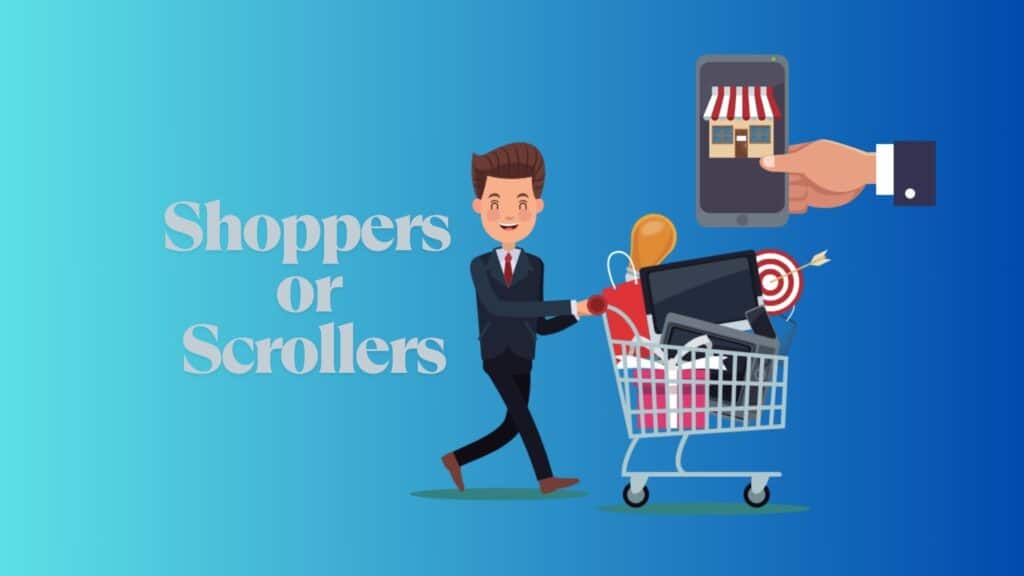Are you spending thousands of dollars on ad marketing without a positive outcome? Could it be that your focus is more on scrollers (silent observers) than on shoppers (the actual buyers)? If that’s the case, then your social commerce strategy isn’t being correctly targeted.
People are shopping while they scroll. For instance, TikTok Shop made over $100 million in a day during Black Friday. Gen-Zs were buying and recording reaction videos, a win-win situation. On the other hand, over 8 million US citizens have joined social shopping in just two years. Social media is no longer about likes and shares; it’s now a trust hub. So, how do you know your target?
Difference Between Shoppers and Scrollers
Before we dive into the meat of the matter, we need to understand what are the crux distinctions between these two groups. Here’s the difference:
- Shoppers: These are the people who visit your store, take out their wallets, and pay for items.
- Scrollers: These individuals scroll through your content without interacting actively with your ads or posts. They might glance at your store, look at everything, and follow you on social media, but they will leave without liking, commenting, or purchasing.
Think of your scrollers as those people accepting your services or products by nodding their heads, while the shoppers are those more willing to click the “Add to Cart” button.
Scrollers are connected to shoppers in a way — by researching, comparing, and deciding which item or service is more suitable to them, they can easily convert into shoppers. But shoppers are not always scrollers. Understanding this distinction impacts your marketing strategy, which is why the custom audience platform for your Meta ads makes online growth easy.
Should You Target Shoppers or Scrollers?
Generally, prioritizing shoppers or scrollers depends on what you target. Shopping for purpose and need isn’t the same. While shoppers have a higher chance of making purchases, scrollers represent potential shoppers as there’s a likelihood of them converting.
For instance, a shopper purchases more impulsively according to their research and preference. So, the products they buy might differ from one occasion to another. A shopper may be fine purchasing an expensive item for a friend, whereas a scroller might hesitate to buy an inexpensive item for a family member.
Their purpose and needs differ. The target you choose should have a positive impact on your campaign, as they are both worth tackling with different strategies. Let’s look at how effective each approach can be.
Targeting Shoppers
This strategy tends to pay off because these users are often actively involved in buying. They are more of a direct and immediate return on your investments. Shopping for something doesn’t mean they will always consume it. They could be buying to give to someone else.
For instance, during Christmas, they can buy gifts to give to other people. They don’t necessarily have to use it. So, targeting shoppers leads to:
- Increased Conversion Rate: These individuals are more likely to pay for the products or services, thus leading to increased revenue.
- Optimized Resource Allocation: Thanks to their predictable shipping habits, they allow you to allocate marketing resources efficiently, thus increasing the likelihood of positive results.
- Higher Purchase Rate: Shoppers are active users. So, whenever they scroll through your store, they are looking to buy, thus indicating a higher purchase intent.
- Targeted Marketing: Focusing on shoppers helps you understand what they want. This allows you to personalize your marketing strategy to meet their interests and needs.
Valuable strategies to get shoppers to purchase include:
- Website or online store optimization
- Email marketing campaigns
- Customer segmentation
- Targeted advertising
You can also introduce loyalty programs to motivate them to purchase more.
Targeting Scrollers
Targeting scrollers on social media platforms can be an effective strategy depending on how you go about it. Focusing more on strategies that capture scrollers’ attention and turn them into shoppers is more beneficial than targeting those who are scrolling solely. Though they are not actively interacting with your products or services, they consume content and are likely to convert at any given point. By targeting scrollers, you are:
- Building a Community: By creating high-quality content, you build trust with scrollers, and they may become repeat visitors. They can even advocate for your brand, leading to more users.
- Increasing User Engagement: With appropriate strategies, it’s possible to turn them into active users. This will increase engagement through shares, comments, likes, and conversions.
Scrollers becoming repeat visitors to your store or website increases their chance of converting into shoppers. You can maximize their chances by:
- Employing targeted advertising
- Providing high-quality content
- Replying to comments and messages
- Asking open-ended questions can also improve engagement and prompt meaningful discussions.
Conclusion
Marketing is not just about being present, but being relevant. You can only be relevant by personalizing your marketing strategies and increasing their visibility. So, whether you target shoppers or scrollers, effective marketing strategies are essential.


